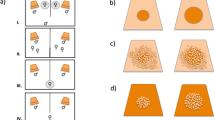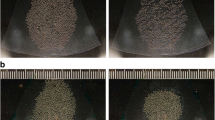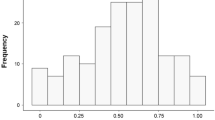Abstract
Laboratory experiments were conducted to determine if the addition of conspecific “foreign” fry affects the survival of “host” fry in the Midas cichlid, Amphilophus xiloaensis. The study consisted of two separate experiments: (1) adoption treatments simulated by adding 75 foreign fry to a host brood containing 150 fry and parents (10 trials where host fry were larger, 10 trials where foreign fry were larger); (2) control treatments in which no foreign fry were added to a host brood containing 150 fry and parents (20 trials). Predation was imposed by introducing three bigmouth sleepers (Gobiomorus dormitor). No significant differences were found between the survival of host, foreign, and control fry after 24 h. Survival was significantly affected by fry size, leading to differential predation on smaller fry. Mean predation rate increased proportionally with brood size, therefore the addition of conspecific foreign fry did not result in dilution of the host brood.


Similar content being viewed by others

References
Barker JM, McKaye KR (2004) Immersion marking of juvenile Midas cichlids with oxytetracycline. North Am J Fish Manage 24:262–269
Barlow GW (1976) The Midas cichlid in Nicaragua. In: Thorson TB (ed) Investigations of the ichthyofauna of Nicaraguan Lakes. School of Life Sciences, University of Nebraska, Lincoln, Neb., pp 333–358
Carr MH (1942) The breeding habits of the eastern stumpknocker, Lemomis punctatus punctatus (Cuvier). J Fla Acad Sci 101–106
Coyne JA, Sohn JJ (1978) Interspecific brood care in fishes: reciprocal altruism or mistaken identity? Am Nat 112:447–450
Darnell RM (1955) Nocturnal terrestrial habits of the tropical gobiod fish Gobiomorus dormitor, with remarks on its ecology. Copeia 1955(3):237–238
Darwin CR (1859) On the origin of species by means of natural selection of the preservation of favoured races in the struggle for life. Murray, London
Eadie JM, Kehoe FP, Nudds TD (1988) Pre-hatch and post-hatch brood amalgation in North American Anatidae: a review of hypotheses. Can J Zool 66:1709–1721
Fraser SA (1996) The influence of predators on adoption behaviour in adult convict cichlids (Cichlasoma nigrofasciatum). Can J Zool 74:1165–1173
Fraser SA, Keenleyside MHA (1995) Why are larger convict cichlid (Cichlasoma nigrofasciatum) fry sometimes adopted into broods of smaller fry? Behav Ecol Sociobiol 37:343–347
Fraser SA, Wisenden BD, Keenleyside MHA (1993) Aggressive behaviour among convict cichlid (Cichlasoma nigrofasciatum) fry of different sizes and its importance to brood adoption. Can J Zool 71:2358–2362
Lewis DSC (1980) Mixed species broods in Lake Malawi cichlids: an alternative to the cuckoo theory. Copeia 1980:874–875
Lowe RH (1952) Report on the Tilapia and other fish and fisheries of Lake Nyasa 1945–47. Colon Off Fish Publ 1(2):1–126
McKaye KR (1977) Competition for breeding sites between the cichlid fishes of Lake Jiloa, Nicaragua. Ecology 58(2):291–302
McKaye KR (1981) Natural selection and the evolution of interspecific brood care in fishes. In: Alexander RD, Tinkle DW (eds) Natural selection of social behavior. Chiron, New York, pp 173–183
McKaye KR (1985) Cichlid-catfish mutualistic defense of young in Lake Malawi, Africa. Oecologia 6:358–363
McKaye KR (1986) Mate choice and size assortative pairing by the cichlid fishes of Lake Jiloa, Nicaragua. J Fish Biol 29 (Suppl A):135–150
McKaye KR, Barlow GW (1976) Chemical recognition of young by the Midas cichlid Cichlasoma citrinellum. Copeia 1976:276–282
McKaye KR, van den Berghe EP (1996) Parallel evolution of a complex feeding behavior by African and Central American Cichlids. Ichthyol Explor Freshw 7:143–148
McKaye KR, Hallacher L (1973) The Midas cichlid of Nicaragua. Pac Discovery 526(5):1–8
McKaye KR, McKaye NM (1977) Communal care and kidnapping of young by parental cichlids. Evolution 31:674–681
McKaye KR, Oliver MK (1980) Geometry of a selfish school: defense of cichlid young by bagrid catfish in Lake Malawi, Africa. Anim Behav 28:1287–1290
McKaye KR, Weiland DJ, Lim TM (1979) The effect of luminance upon the distribution and behavior of the eleotrid fish Gobiomorus dormitor, and its prey. Rev Can Biol 38(1):27–36
McKaye KR, Mughogho EE, Lovullo TJ (1992) Formation of the selfish school. Environ Biol Fish 35:213–218
McKaye KR, Stauffer JR, McCrary JK (2001) The Midas cichlid species complex of Nicaragua: evidence for sympatric speciation? Cichlid News 10:28–34
McKaye KR, Stauffer JR Jr, van den Berghe EP, Vivas R, Lopez Perez LJ, McCrary JK, Waid R, Konings A, Lee W, Kocher TD (2002) Behavioral, morphological and genetic evidence of divergence of the Midas cichlid species complex in two Nicaraguan crater lakes. Cuad Invest UCA 12:19–47
Murry BA, McKaye KR (2001) Temporal stability in parental brood defense behavior by the Midas cichlid, Amphilophus citrinellus, in Lake Xiloa, Nicaragua. J Aquaric Aquat Sci 9:134–149
Murry BA, van den Berghe EP, McKaye KR (2001) Brood defense behavior of three sibling species in the Amphilophus citrinellus species complex in Lake Xiloá, Nicaragua. J Aquaric Aquat Sci 9:134–149
Myrberg AA (1966) Parental recognition of young in cichlid fishes. Anim Behav 14:565–571
Noble GK, Curtis B (1939) The social behavior of the jewel fish Hemichromis bimaculatus (Gill). Bull Am Mus Nat Hist 76:1–46
Payne RB (1977) The ecology of brood parasitism in birds. Annu Rev Ecol Syst 8:1–28
Perrone M Jr (1978) Mate size and breeding success in a monogamous cichlid fish. Environ Biol Fish 3:193–201
Pitcher TJ (1986) Functions of shoaling behaviour in teleosts. In: Pitcher TJ (ed) The behaviour of teleost fishes. Croom Helm, London, pp 294–337
Riedman ML (1982) The evolution of alloparental care and adoption in mammals and birds. Q Rev Biol 57:405–435
Stauffer JR, McKaye KR (2001) Naming of cichlids. J Aquaric Aquat Sci 9:1–16
Stauffer JR Jr, McKaye KR (2002) Descriptions of three new species of cichlid fishes (Teleostei: Cichlidae) from Lake Xiloa, Nicaragua. Cuad Invest UCA 12:1–18
Stauffer JR Jr, Bowers NJ, McKaye KR, Kocher TD (1995) Evolutionary significant units among cichlid fishes: the role of behavioral studies. Trans Am Fish Soc Symp 17:227–244
Taborsky M (1994) Sneakers, satellites and helpers: parasitic and cooperative behavior in fish reproduction. Adv Stud Behav 23:1–100
Tate AH (1998) Initial six-year expansion of an introduced piscivorous fish in Lake Apoyo, Nicaragua. Master’s Thesis, University of Maryland
Vivas RP, McKaye KR (2001) Habitat selection, feeding ecology and fry survivorship in the Amphilophus citrinellus in Lake Xiloa, Nicaragua. J Aquaric Aquat Sci 9:32–48
Waid RM, Raesly RL, McKaye KR, McCrary JK (1999) Zoogeografia ictica de lagunas cratericas de Nicaragua. Encuentro 51:65–80
Wisenden BD (1999) Alloparental care in fishes. Rev Fish Biol Fish 9:45–70
Wisenden BD (2001) Brood defense and optimal brood size in convict cichlids Cichlasoma (Archocentrus) nigrofasciatus, a species with biparental care. J Aquaric Aquat Sci 9:303–320
Wisenden BD, Keenleyside MHA (1992) Intraspecific brood adoption in convict cichlids: a mutual benefit. Behav Ecol Sociobiol 4:263–269
Wisenden BD, Keenleyside MHA (1994) The dilution effect and differential predation following brood adoption in free-ranging convict cichlids (Cichlasoma nigrofasciatum). Ethology 96:203–212
Yanagisawa Y (1985) Parental strategy of the cichlid fish Perissodus microlepis, with particular reference to intraspecific brood “farming out”. Environ Biol Fishes 12:241–249
Acknowledgements
Thanks to Ray Morgan for his help with the development of the manuscript, to Bianca McIntyre and Angela Burns for their help in the lab, and to John Hoogland and Brent Murry for their valuable comments on the manuscript. This project was conducted at the Appalachian Laboratory in Frostburg, Md. This paper is Scientific Contribution no. 3805 of the University of Maryland Center for Environmental Science, Appalachian Laboratory.
This experiment complies with the current laws of the United States and the University of Maryland Center for Environmental Science Institutional Animal Care and Use Committee. The experiment was performed under IACUC no. S-AL-01-02.
Author information
Authors and Affiliations
Corresponding author
Additional information
Communicated by Rui F. Oliveira
Rights and permissions
About this article
Cite this article
Fulton, J.B., McKaye, K.R. & Hilderbrand, R.H. The role of dilution and differential predation in brood adoptions of the Midas cichlid (Amphilophus xiloaensis). acta ethol 7, 81–87 (2004). https://doi.org/10.1007/s10211-004-0098-9
Received:
Revised:
Accepted:
Published:
Issue Date:
DOI: https://doi.org/10.1007/s10211-004-0098-9



